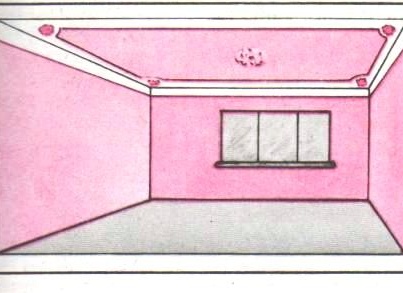When replacing wall decoration with glue paint on wallpaper, glue paint must be scraped off with metal spatulas and washed off (using a brush with water). Paste over the entire surface of the wall with newspapers.
In those places where there are fears of cracks (adjoining walls to doors, windows, etc.), it is necessary to glue 4-5 cm wide gauze strips before newspaper stickers.
The height of the walls determines the length of the glued canvas and then on the floor on a newspaper litter unfold pieces of wallpaper and cut into separate panels with the obligatory selection of a picture. Domestic wallpapers have an edge that needs to be trimmed on one side. Wallpaper begins to glue from the window (from the light) to the left and right. Based on this principle, they trim the edge on the left or right side on the desired number of panels. The number of required panels is determined by dividing the wall to be glued to the width of the wallpaper piece or simply applying a piece of wallpaper to the wall. With incorrect pasting - to the light (to the window) the seams will be noticeable.
Imported wallpaper has no edges and is glued butt.
Harvested canvases of wallpaper are collected in one pack on the floor, turned face down and laid on a bed of newspapers.
Work on pasting is done by two people. A cloth smeared with a brush is transferred to a ladder or stand; the latter presses the cloth to the top of the wall, and the second person evenly pulls the cloth down. Working at the top with a clean rag smooths the canvas and presses it against the wall, avoiding air bubbles. Hand movement with a rag: from above - down and left, from above - down and to the right (in a semicircle or obliquely).
Skirting boards, covers of sockets and switches must be removed. Electricity is better off. Wallpaper is pasted both from the ceiling and by stepping back 10-15 cm. To top the wallpaper was on the same level, under the ceiling, you can beat off the line of gluing (similarly, the line is beaten to the color of the panels). Any line, at least horizontal, at least inclined, beats off according to the principle: two people pull a thin cord coated with blue (or other pigment) and bring it to the wall. The third pulls the cord in the middle and lets go on the wall. The principle of slingshot. The horizontal line is set using the water level.
In practice, they usually do not glue with such accuracy, but simply lay the same distance from the ceiling of the room in different angles and beat off the line.
The second web is glued butt with the first, observing the coincidence of the pattern.The subsequent web is glued to the uncut edge of the previous one. Imported wallpapers are glued butt. With them you need to be very accurate or glued using linkrust technology.
If glue gets on the front of the wallpaper, do not be scared, after drying the glue will be invisible.
A pasta is prepared from flour or starch; it is prepared in the same way as jelly. Or apply ready-made wallpaper glue.
Ceilings are glued using the same technology as walls. First, newspapers are glued, then wallpaper. One person presses the edge of the panel to the ceiling, the other holds the panel. Then the first, moving along the canvas, presses and smooths the wallpaper with a rag to the ceiling. The task of the second is to constantly keep the wallpaper on weight. For the ceiling, it is better to choose light wallpaper with a small pattern. Sometimes the wallpaper on the ceilings and walls glue the same pattern. Moreover, completely, i.e. Wallpaper from the ceiling, as it were, passes to the walls. In my opinion, this is not very beautiful, but there is no friend for the taste and color. Personally, I am more impressed by the decoration shown in Fig. 23.

Wallpaper on the ceiling and walls do not reach an angle of 10-15 cm. The corners of the ceiling wallpaper are cut in half-steep. The edges of the wallpaper on the ceiling and walls are fritted with tape. In the corners of the ceiling, one flower is glued, cut from the same wallpaper. In the place of attachment of the chandelier made alabaster "rosette". Clean corners not occupied by wallpaper are stained with water-based paint.
On the ceiling, the edges of the wallpaper are difficult to combine, so when gluing, better follow the coincidence of the picture, and then cut the edges with a blade. The old tape is glued last, after painting. The ribbon gives the finish a finished look and looks great with wallpapers of any color and pattern. It is glued on the same glue. Any tape is used, both cassette and reel.
Before pasting the wallpaper on previously whitewashed ceilings, the whitewash needs to be scraped off and washed off. The laziest ceilings for sticking or oil painting may not be washed, but simply proliferated with a roller and dried. But in this case no one is responsible for the quality. It’s crap.
Washable, satin and pile wallpapers are similarly glued. For them we apply glue "Bustilat".
The main thing when drying wallpaper (about a week) is not to open the windows and windows, otherwise the wallpaper will fall off.
